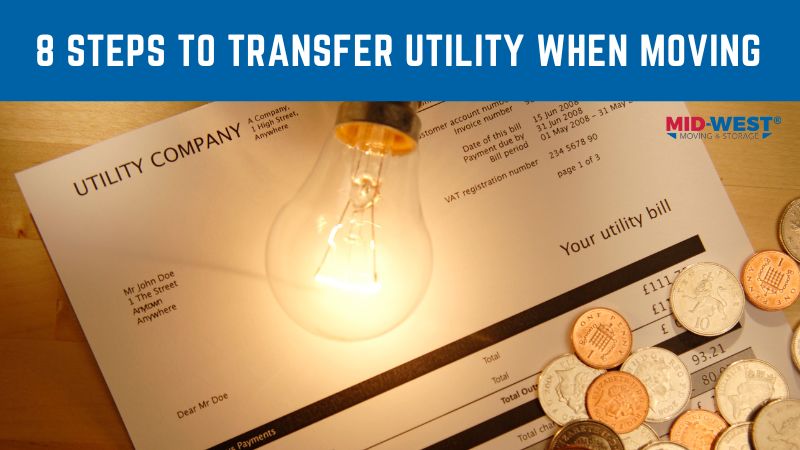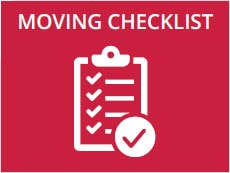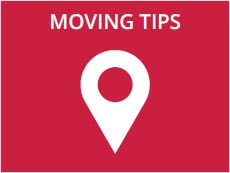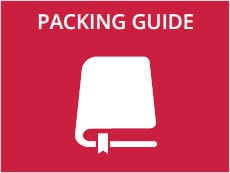Last Updated on August 27, 2025 by Kari-Ann Ryan
When relocating to a new home, one of the most important tasks is transferring utilities. No one wants to arrive and find the lights out, the water off, or no internet connection. Whether you’re renting or buying, arranging utility transfers ahead of time ensures a smooth transition. Here’s what you need to know to handle the process effectively.
What Are Common Household Utilities?
Utilities are what make a home comfortable, convenient, and safe. Some of the most common household utilities include:
- Electricity, which powers lights, appliances, electronics, and heating systems
- Gas for cooking and keeping your home warm
- Water, essential for drinking, cleaning, and daily hygiene
- Sewage, which safely removes wastewater from your home
- Internet to stay connected for work, school, and entertainment
- Trash and recycling services to help keep your home clean
- Cable or satellite TV, which many households consider a standard utility
- Landline phones, still used by some families
- Security and alarm systems that monitor and protect your home
Keeping a list of all your current utilities before moving helps prevent interruptions in service and avoids missing any important connections.
Step-by-Step Guide to Moving Your Utilities
Follow our step-by-step guide to make transferring your utilities easier and avoid any interruptions during your move.
Step 1: Identify Current Utilities
The first step in transferring the utilities is to organize the utility services in a list. Create a spreadsheet or checklist of what utilities are currently in use and the contact information of the providers. Include the account numbers, customer service numbers, and billing information when compiling the list.
A helpful trick is to create a simple checklist or calendar for your move. Mark when each service needs to be shut off at your old place and turned on at the new one. For a detailed guide, check out our walkthrough checklist before moving into a new apartment
Step 2: Research New Utility Providers
Utility providers deliver services in the area. For example, sewer, water, and trash services are restricted to local towns. Before moving across state lines, research new utility providers in the vicinity. Visit the website of the new county or city, or ask the realtor or landlord for guidance.
Upon finding utility services in the new town, set up new accounts. Provide them with the address to the new home as well as any other necessary information. Setting up new accounts may come with deposits or fees—so be sure to inquire about these.
Step 3: Notify Existing Providers
Give current utility providers advanced notice. If possible, notify them 2 to 4 weeks before moving to schedule technicians for services, like internet and cable. Gas or electricity can usually be transferred by phone. Other utilities, however, may require in-person ID verification or deposits.
Schedule the disconnection of utilities one day after moving out and activation one day prior to moving in. This time frame prevents gaps in services. When moving to a cold climate, heating the home before arriving offers greater comfort. Similarly, if renovating the home, contractors will need lighting.
Step 4: Contact the City’s Utility Office
Make arrangements for water and sewer services with the new city’s utilities office well in advance of arriving. Homeowners should be prepared with proof of residency, such as closing documents, and renters should provide a copy of the lease. Also ask about recycling and trash pickup days.
Step 5: Determine Who Covers Utilities
Renters should ask the landlord which party is responsible for the utilities. Individuals moving into a condo or townhome are urged to check with their homeowner’s association (HOA) to determine what is covered; this step prevents individuals from paying twice for the same services.
Common utilities covered by the HOA include water and sewer, especially if a single meter is used for the whole building. The HOA may be responsible for snow removal, landscaping, and trash pickup. The HOA fees are unlikely to cover the electricity, internet, and gas bills.
Step 6: Update the Address
As mentioned, provide the current utility services with the new mailing address. They may send service updates as well as the final bill. After providing the new mailing address, use the convenience of mail forwarding services with the USPS to ensure mail delivery remains uninterrupted.
Also update the bank, credit card providers, and insurers with the new home mailing address to receive deposit refunds and other important information about the old accounts. Inquire about any procedures or paperwork that must be completed prior to closing the utility accounts.
Step 7: Request a Final Meter Reading
Ask the current utility provider for a final meter reading to accurately determine the final bill. Take a photo of the meter reading on the day of move-out to serve as backup. This step prevents being overcharged, settles security deposit disputes, and ensures accurate closing documents.
Step 8: Pay Outstanding Utility Bills
Outstanding utility bills can harm an individual’s credit score. They can also interfere with utility transfers. Prevent potential issues by settling unpaid bills or asking if a balance is due. Especially when renting a property, keep the receipts with personal records.
Understanding Utility Costs Before Your Move
When planning a move, it’s easy to overlook the fees that come with transferring utilities. Being prepared helps you avoid unexpected expenses and keeps your move on budget. Many providers may charge deposits, connection fees, or reconnection fees, especially for first-time customers.
For example, electricity or gas companies might request a deposit, while internet or cable services can include installation or equipment charges. Knowing these costs ahead of time allows you to plan your finances and prevents last-minute surprises.
Tips to save money:
- Ask your current provider if they can waive deposits based on your payment history
- Compare fees between providers in your new area
- Keep all receipts for deposits or setup fees, as some may be refundable
How to Plan Your Utility Timeline for a Smooth Move
Timing your utility transfers is one of the easiest ways to make your move feel less chaotic. Each service works on a different schedule, so planning ahead means you won’t step into a new home without the essentials.
For instance, getting internet set up can take up to two weeks if a technician has to come to your home. Electricity and gas are usually quicker and can often be handled with a phone call. City-run services like water, trash, and sewer may take a few days to start once you submit your request.
A helpful trick is to create a simple checklist or calendar for your move. Mark when each service needs to be shut off at your old place and turned on at the new one. If you can have everything active at least a day before moving in, you’ll arrive to a home that’s fully functional and ready to live in.
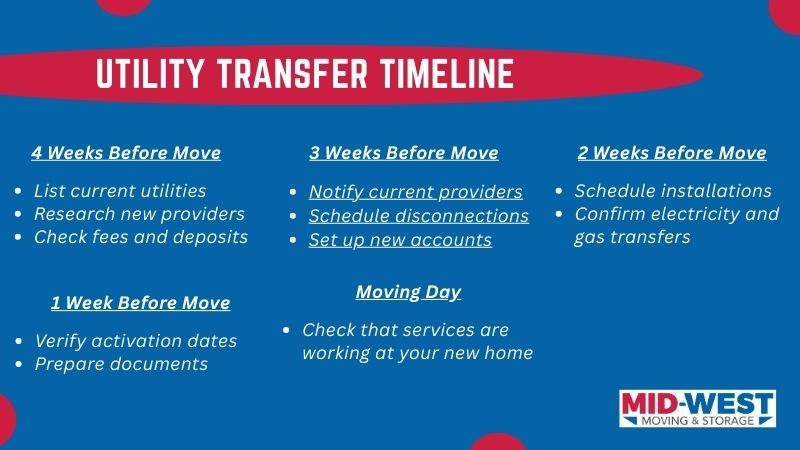
What are the Essential Documents for Utility Transfers
Utility providers typically require proof of residency and identification, so having these ready can prevent delays.
Common documents to have include
- Lease agreement if you’re renting, or closing papers if you’re buying a home
- Government-issued ID such as a driver’s license or passport
- Social Security number or other personal identification for account verification
- Recent utility bills from your current providers to confirm your account history
Having these documents organized ahead of time allows you to set up new services efficiently and helps you settle into your new home without unexpected complications.
Residential Moving Services with Mid-West Moving and Storage
Relocating to a new area involves several steps to ensure it proceeds smoothly. One of these steps includes working with a reputable moving company, like Mid-West Moving & Storage. Our decades of industry experience allow us to provide customers with a move that is as stress-free as possible.
As a top-notch residential moving service, we help individuals and families move to and from homes, condos, apartments, dorms, retirement communities, and more. Our moving crews are capable of safely handling a wide range of household goods, from bulky items to fragile artwork.
We also offer numerous conveniences to make the relocation process easier. Packing and unpacking services are available. If you need to store items, our short- and long-term storage options are ideal. Plus, our professionals create a detailed plan of the move, including the layout of furniture.
When you’ve set a move date, the next step is consulting a reliable professional mover. Mid-West Moving and Storage is the number one choice for Chicagoland residents. Call our Elk Grove Village, Illinois, office at 847.593.7201 to jumpstart the planning of your exciting upcoming relocation.
Frequently Asked Questions
Can you transfer utilities when you move?
Yes, most utilities can be transferred to your new home. Services like electricity, gas, and water can often be transferred online or over the phone, while internet, cable, and security systems may require scheduling a technician. By planning ahead and following our step-by-step utility transfer guide, you can ensure your new home is fully connected on move-in day. Mid-West Moving & Storage can help you plan the timeline so all services are active when you arrive.
How long does it take to switch utilities?
Switching utilities depends on the type of service. Electricity and gas transfers usually take 1–3 business days, while internet or cable installation can take up to 2 weeks if a technician visit is required. City-managed services like water, sewer, and trash may take a few days to activate. Planning your timeline in advance, as recommended by Mid-West Moving & Storage, ensures you won’t experience any service gaps during your move.

Director of Marketing & Development
Kari-Ann Ryan is a dynamic marketing strategist with a proven track record in brand development, corporate visibility, and business growth. As the Director of Marketing & Development for Mid-West Moving & Storage and Chicago Office Movers, she leads all branding, marketing, and business development initiatives, driving awareness and engagement across multiple industries.
With extensive experience in multi-brand marketing, nonprofit fundraising, event planning, and retail management, Kari-Ann brings a comprehensive and results-driven approach to her role. She is a dedicated leader in the business community, actively involved in the Schaumburg Business Association and the GOA Regional Business Association. She also serves as a Board Member for the Alzheimer’s Association Illinois Chapter, reinforcing her commitment to advocacy and philanthropy.
In addition to her corporate role, Kari-Ann is the founder of LMJ’s Lost Souls – Alzheimer’s Fund, a nonprofit organization dedicated to awareness, education, and fundraising for Alzheimer’s research and support.
She holds a Bachelor of Business Administration in Marketing from Western Michigan University and is Certified in Constant Contact Email Marketing, with expertise in social media strategy and digital engagement.

